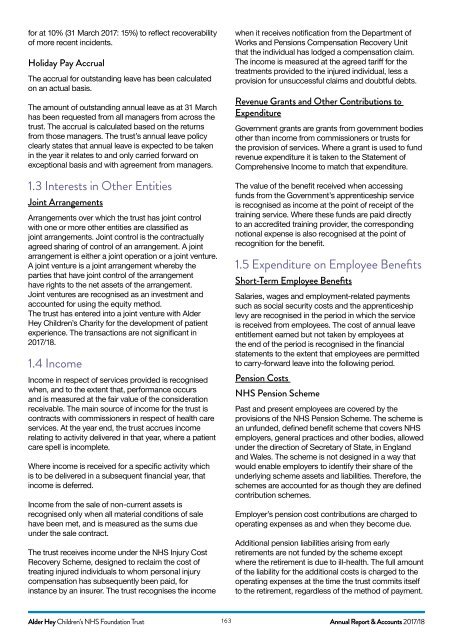AH ANNUAL REPORT 2018
You also want an ePaper? Increase the reach of your titles
YUMPU automatically turns print PDFs into web optimized ePapers that Google loves.
for at 10% (31 March 2017: 15%) to reflect recoverability<br />
of more recent incidents.<br />
Holiday Pay Accrual<br />
The accrual for outstanding leave has been calculated<br />
on an actual basis.<br />
The amount of outstanding annual leave as at 31 March<br />
has been requested from all managers from across the<br />
trust. The accrual is calculated based on the returns<br />
from those managers. The trust’s annual leave policy<br />
clearly states that annual leave is expected to be taken<br />
in the year it relates to and only carried forward on<br />
exceptional basis and with agreement from managers.<br />
1.3 Interests in Other Entities<br />
Joint Arrangements<br />
Arrangements over which the trust has joint control<br />
with one or more other entities are classified as<br />
joint arrangements. Joint control is the contractually<br />
agreed sharing of control of an arrangement. A joint<br />
arrangement is either a joint operation or a joint venture.<br />
A joint venture is a joint arrangement whereby the<br />
parties that have joint control of the arrangement<br />
have rights to the net assets of the arrangement.<br />
Joint ventures are recognised as an investment and<br />
accounted for using the equity method.<br />
The trust has entered into a joint venture with Alder<br />
Hey Children’s Charity for the development of patient<br />
experience. The transactions are not significant in<br />
2017/18.<br />
1.4 Income<br />
Income in respect of services provided is recognised<br />
when, and to the extent that, performance occurs<br />
and is measured at the fair value of the consideration<br />
receivable. The main source of income for the trust is<br />
contracts with commissioners in respect of health care<br />
services. At the year end, the trust accrues income<br />
relating to activity delivered in that year, where a patient<br />
care spell is incomplete.<br />
Where income is received for a specific activity which<br />
is to be delivered in a subsequent financial year, that<br />
income is deferred.<br />
Income from the sale of non-current assets is<br />
recognised only when all material conditions of sale<br />
have been met, and is measured as the sums due<br />
under the sale contract.<br />
The trust receives income under the NHS Injury Cost<br />
Recovery Scheme, designed to reclaim the cost of<br />
treating injured individuals to whom personal injury<br />
compensation has subsequently been paid, for<br />
instance by an insurer. The trust recognises the income<br />
when it receives notification from the Department of<br />
Works and Pensions Compensation Recovery Unit<br />
that the individual has lodged a compensation claim.<br />
The income is measured at the agreed tariff for the<br />
treatments provided to the injured individual, less a<br />
provision for unsuccessful claims and doubtful debts.<br />
Revenue Grants and Other Contributions to<br />
Expenditure<br />
Government grants are grants from government bodies<br />
other than income from commissioners or trusts for<br />
the provision of services. Where a grant is used to fund<br />
revenue expenditure it is taken to the Statement of<br />
Comprehensive Income to match that expenditure.<br />
The value of the benefit received when accessing<br />
funds from the Government’s apprenticeship service<br />
is recognised as income at the point of receipt of the<br />
training service. Where these funds are paid directly<br />
to an accredited training provider, the corresponding<br />
notional expense is also recognised at the point of<br />
recognition for the benefit.<br />
1.5 Expenditure on Employee Benefits<br />
Short-Term Employee Benefits<br />
Salaries, wages and employment-related payments<br />
such as social security costs and the apprenticeship<br />
levy are recognised in the period in which the service<br />
is received from employees. The cost of annual leave<br />
entitlement earned but not taken by employees at<br />
the end of the period is recognised in the financial<br />
statements to the extent that employees are permitted<br />
to carry-forward leave into the following period.<br />
Pension Costs<br />
NHS Pension Scheme<br />
Past and present employees are covered by the<br />
provisions of the NHS Pension Scheme. The scheme is<br />
an unfunded, defined benefit scheme that covers NHS<br />
employers, general practices and other bodies, allowed<br />
under the direction of Secretary of State, in England<br />
and Wales. The scheme is not designed in a way that<br />
would enable employers to identify their share of the<br />
underlying scheme assets and liabilities. Therefore, the<br />
schemes are accounted for as though they are defined<br />
contribution schemes.<br />
Employer’s pension cost contributions are charged to<br />
operating expenses as and when they become due.<br />
Additional pension liabilities arising from early<br />
retirements are not funded by the scheme except<br />
where the retirement is due to ill-health. The full amount<br />
of the liability for the additional costs is charged to the<br />
operating expenses at the time the trust commits itself<br />
to the retirement, regardless of the method of payment.<br />
Alder Hey Children’s NHS Foundation Trust 163<br />
Annual Report & Accounts 2017/18


